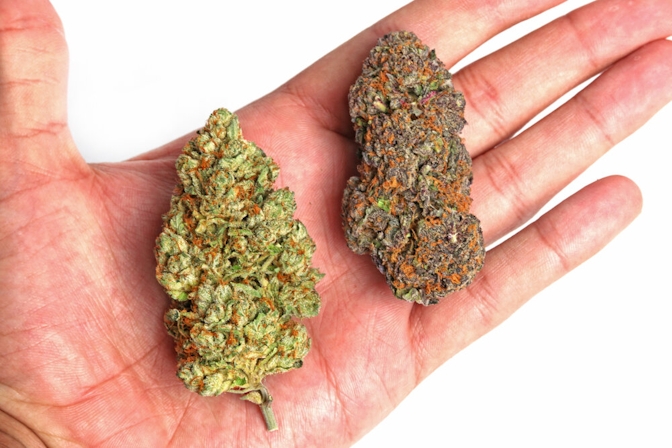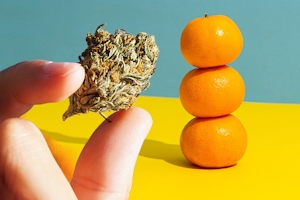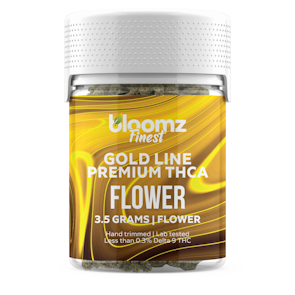
Indica vs. Sativa vs. Hybrid: Diferences
The world of cannabis can be a complex endeavor, particularly when it comes to understanding the differences between various marijuana strains.
In this guide, we’ll explore the unique characteristics of cannabis indica, cannabis sativa, and hybrid strains, examining their unique effects, their concentrations of cannabinoids and terpenes, and how these factors can influence your overall experience with cannabis products.
What Are Indica Strains?

Cannabis indica strains, often associated with relaxation and tranquility, are typically consumed during the evening or before bed. Originating from regions such as Afghanistan, India, and Turkey, where the climate is harsh and variable, cannabis indica plants have evolved to be small and bushy with broad leaves, well-suited to harsher climates. This physical characteristic allows them to absorb as much sunlight as possible and complete their flowering cycle quickly before winter arrives.
Indica strains are known for their rich concentration of cannabinoids, particularly THC (tetrahydrocannabinol), the psychoactive compound responsible for the plant’s intoxicating effects. They also have a higher CBD (cannabidiol) concentration, a non-psychoactive compound with a range of potential therapeutic applications, from pain relief to anxiety reduction.
Consumers of indica strains often report feelings of deep body relaxation, calmness, and even drowsiness. These strains are typically recommended for nighttime use because they can help with insomnia and other sleep disorders. Other potential therapeutic benefits include muscle spasm relief, chronic pain management, and anxiety reduction.
The Ultimate Indica Experience From Bloomz
Kush Cake is a popular Indica-dominant strain, known for its relaxing effects. Bloomz’s Kush Cake takes this relaxation to the next level with the potential benefits of THCA (Tetrahydrocannabinolic Acid), offering a unique and enjoyable smoking experience.
Indica strains like Kush Cake are perfect for unwinding after a long day, thanks to their deep relaxation effects. Bloomz’s Kush Cake is carefully crafted to offer enhanced relaxation and therapeutic benefits, making it truly special.
Here’s what makes Bloomz’s Kush Cake THCA Flower stand out:
Quality: We pride ourselves on using only the highest quality hemp flowers in our products. Each flower is carefully selected and hand-trimmed to ensure you get nothing but the best.
Potency: With a high THCA content, our flowers promise a potent experience. Whether you’re an experienced smoker or just starting out, you can adjust your intake to suit your tolerance levels.
Flavor: Our Kush Cake offers a rich, earthy, and slightly sweet flavor profile that perfectly complements the relaxing effects of the strain.
Convenience: No need to worry about rolling your own joints; simply pack a bowl and enjoy!
What Are Sativa Strains?
Cannabis sativa strains, on the other hand, are generally associated with energizing and uplifting effects. These strains are native to equatorial regions like Southeast Asia, Central America, and Africa, where the climate is consistently warm, and length of daylight remains relatively constant throughout the year. As a result, sativa plants have evolved to be tall and slender, with narrow leaves to adapt to the high humidity of these regions.
Unlike indica strains, sativa strains tend to have a higher THC to CBD ratio, contributing to their stimulating effects. Consumers often describe the sativa high as cerebral, promoting creativity, productivity, and general upliftment in mood. These characteristics make sativa strains ideal for social gatherings and creative pursuits, and they are generally recommended for daytime use.
Beyond their energizing effects, sativa strains may have potential therapeutic benefits, including alleviation of mood disorders, increased focus and creativity, and relief from chronic pain. They’re also known for their potential to stimulate appetite, which can be beneficial for people dealing with appetite loss.
What Are Hybrid Strains?
Hybrid cannabis strains are bred from both indica and sativa strains to create a balanced mix of their parent strains’ characteristics. Breeders can control the ratio of indica to sativa, allowing consumers to select hybrid strains based on their unique needs and preferences.
Hybrid strains can be indica-dominant, sativa-dominant, or an even split between the two, offering a wide spectrum of potential effects. For example, an indica-dominant hybrid might provide significant body relaxation coupled with a mild cerebral buzz, while a sativa-dominant hybrid could offer a potent cerebral high with slight body relaxation.
The strength and balance of effects in hybrid strains depend on the precise combination of indica and sativa genetics. The goal is to provide consumers with a tailored cannabis experience that can offer the relaxing effects of indica strains, the energizing effects of sativa strains, or a balanced combination of both.
These carefully cultivated hybrids allow for a highly customizable cannabis experience, making them popular among both medicinal and recreational users. From managing chronic pain to stimulating creativity, hybrids provide a wide array of options for cannabis consumers.
Indica Vs. Sativa Vs. Hybrid: What Is The High Like?
The effects or “high” a consumer experiences after consuming cannabis products depend greatly on the type of strain used, whether it’s indica, sativa, or a hybrid. These different strains produce distinct sensations due to their unique combinations of cannabinoids and terpenes. Let’s delve into what kind of high you can expect from each type.
Indica High
Consumers of cannabis indica strains commonly describe the high as a “body buzz” or a “couch-lock” effect. This is because indica strains are traditionally associated with strong physical relaxation. This heavy, sometimes sedating, body high makes indica strains perfect for unwinding at the end of the day, watching a movie, or preparing for sleep. Many medical cannabis patients choose indica strains for their potent pain-relieving properties, their ability to ease insomnia, and their potential to reduce anxiety and stress.
Sativa High
In contrast, cannabis sativa strains produce what is often described as a cerebral, uplifting high. The sativa high is characterized by a boost in creativity, energy, and a sense of euphoria. It’s not uncommon for consumers to report enhanced sensory experiences, such as brighter colors or heightened auditory sensations. Sativa strains can potentially be helpful for those looking to stimulate their appetite, reduce depression or anxiety symptoms during the day, or simply gain an energy boost. As such, sativa strains are popular for daytime use and social situations.
Hybrid High
The effects of hybrid strains depend on the balance of indica and sativa in their genetic makeup, resulting in a high that blends the characteristics of both parent strains. For instance, an evenly balanced hybrid might offer moderate body relaxation (from its indica parent) along with mental clarity and creativity (from its sativa parent).
Indica-dominant hybrids typically produce a high that leans more towards the relaxing and sedative effects of indica strains while still offering a mild cerebral effect from the sativa lineage. On the other hand, Sativa-dominant hybrids provide a stimulating and uplifting high with a subtle relaxing undertone.
Hybrid strains are particularly popular because they can deliver a well-rounded experience, combining the best aspects of both indica and sativa strains. They are a perfect choice for consumers seeking a versatile cannabis experience or those new to cannabis products looking to explore a balanced mix of effects.
Indica Vs. Sativa Vs. Hybrid: Cannabinoids & Terpenes
When comparing indica, sativa, and hybrid strains, it’s crucial to understand the roles of cannabinoids and terpenes, the two major groups of compounds found in cannabis that contribute significantly to their effects.
Cannabinoids
Cannabinoids are unique chemical compounds found in cannabis plants that interact with the human body’s endocannabinoid system to produce various effects. The most well-known cannabinoids are THC (tetrahydrocannabinol) and CBD (cannabidiol).
THC is the primary psychoactive component in cannabis that gives users a “high.” Indica strains often have higher THC content, contributing to their intense body highs. Sativa strains, while also containing THC, typically have a higher ratio of CBD, which is non-psychoactive and known for its potential therapeutic effects such as reducing anxiety and inflammation.
Hybrid strains, depending on their parentage, can have a balance of THC and CBD, allowing consumers to experience a mix of psychoactive and therapeutic effects.
Terpenes
Terpenes are aromatic compounds found in various plants, including cannabis. They give each cannabis strain its distinctive smell and taste. But beyond that, terpenes also play a key role in the effects of different strains.
For instance, the terpene myrcene, often found in high concentrations in indica strains, is associated with relaxing effects. On the other hand, limonene, commonly present in sativa strains, is thought to provide uplifting and energizing effects.
Hybrids, being a mix of indica and sativa, can contain a diverse range of terpenes, contributing to their complex aroma profiles and unique effects.
What Strain Is Best For You?
The perfect strain for you depends on your individual preferences and needs. Below are some highly recommended strains from each category:
Best Sativa: Sour G
Sour G is a sativa strain known for its uplifting and energizing effects, which can be great for daytime use. It also has a unique flavor profile, combining notes of citrus and diesel. It is a great choice if you want to stay active and focused throughout the day.
Best Indica: Bubba Kush
Bubba Kush is a popular indica strain renowned for its strong, sedative effects. With a sweet, earthy flavor profile, this strain is perfect for unwinding at the end of a long day or when you’re ready for deep, restful sleep.
Best Hybrid: Sour Space Candy
Sour Space Candy is a balanced hybrid strain that delivers the best of both worlds. It offers uplifting, mood-enhancing effects typical of sativa strains while also providing the relaxing, body-focused effects common in indica strains. Its unique flavor profile combines notes of citrus, berry, and candy.
Ultimately, the best thing you can do is try each type of strain and decide which one you prefer. Each strain offers a different set of effects and exploring them can be a journey of self-discovery. Remember, the staff at your local dispensary can be an excellent resource for recommending cannabis products that align with your needs and desires.
Herb Recommended Products:
READ MORE











